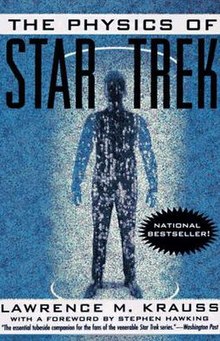The Physics of Star Trek
 |
|
| Author | Lawrence M. Krauss |
|---|---|
| Country | United States |
| Language | English |
| Subject | Physics and Star Trek |
| Genre | Non-fiction |
| Publisher | HarperPerennial |
|
Publication date
|
1995 |
| Media type | Print (Hardcover and Paperback) |
| Pages | 208 |
| ISBN | (hardcover) (revised and updated edition) |
| OCLC | 32925425 |
| 791.45/72 20 | |
| LC Class | QB500 .K65 1995 |
| Preceded by | Fear of Physics: A Guide for the Perplexed |
| Followed by | Beyond Star Trek |
The Physics of Star Trek is a 1995 non-fiction book by the theoretical physicist Lawrence M. Krauss. It is the third book by Krauss, who later wrote a followup titled Beyond Star Trek in 1997.
Krauss discusses the physics involved in various concepts and objects described in the Star Trek universe. He investigates the possibility of such things as inertial dampers and warp drive, and whether physics as we know it would allow such inventions. He also discusses time travel, light speed, pure energy beings, wormholes, teleportation, and other concepts that are staples of the Star Trek universe. The book includes a foreword by astrophysicist Stephen Hawking.
The Physics of Star Trek was met with generally positive reviews. It became a national bestseller and sold more than 200,000 copies in the United States. As of 1998, it was being translated into 13 different languages. It was also the basis of a BBC television production.
Krauss got the idea for writing the book from his publisher, who initially suggested it as a joke. Krauss dismissed the idea but later thought that using Star Trek might get people interested in real physics.
The hardcover edition was published in November 1995, and a paperback edition followed in September 1996. The book was fully revised and updated by Krauss in 2007. Krauss's next book, Beyond Star Trek: Physics from Alien Invasions to the End of Time, was published in 1997.
...
Wikipedia
